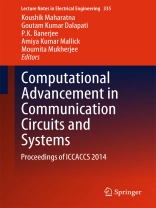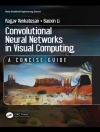This book comprises the proceedings of 1st International Conference on Computational Advancement in Communication Circuits and Systems (ICCACCS 2014) organized by Narula Institute of Technology under the patronage of JIS group, affiliated to West Bengal University of Technology. The conference was supported by Technical Education Quality Improvement Program (TEQIP), New Delhi, India and had technical collaboration with IEEE Kolkata Section, along with publication partner by Springer.
The book contains 62 refereed papers that aim to highlight new theoretical and experimental findings in the field of Electronics and communication engineering including interdisciplinary fields like Advanced Computing, Pattern Recognition and Analysis, Signal and Image Processing. The proceedings cover the principles, techniques and applications in microwave & devices, communication & networking, signal & image processing, and computations & mathematics & control. The proceedings reflect the conference’s emphasis on strong methodological approaches and focus on applications within the domain of Computational Advancement in Communication Circuits and Systems. The content also emphasizes the emerging technologies in the Electronics and Communication field together in close examinations of practices, problems and trends.
İçerik tablosu
Part 1 Advances in RF, Microwave and Antenna: Chapter 1. Design and Development of Low-Level RF Digital Feedback Loop Synthesized Signal Generator.- Chapter 2. Estimation of Slot Position for a Slotted Antenna.- Chapter 3. Wide-banding of Half Mode Substrate Integrated Waveguide (HMSIW) Filters Using L-slots.- Chapter 4. Broadband Rectangular Microstrip Patch Antennas for K and EHF Bands.- Chapter 5. Design of Dielectric Resonator Antenna with different Dielectric Constants.- Chapter 6. Overview on Various Bandwidth Enhancement Techniques for Ultrawide Band Antennas.- Chapter 7. Investigation on Microwave MEMS Capacitive Shunt Switch by Using Coventor and CST Software.- Chapter 8. Design of Microstrip Lowpass filter in combination with Defected Ground and Defected Microstrip Structures.- Part 2_Advances in Communication System: Chapter 9. Adaptive Power Control Scheme for Cognitive Radio Systems Based on Receiver Sensitivity.- Chapter 10. A Random Bit Generator using RÖssler Chaotic System.- Chapter 11. Optimized Wi MAX Network Development in India: Specification and Implementation.- Chapter 12. Performance Analysis of RTS/CTS Protocol in Accessing Control Channel in Distributed Cognitive Radio Networks.- Chapter 13. Winner Determination Algorithm in Auction Framework of Cognitive Radio Network.- Chapter 14. An Improved Energy Detector for Spectrum Sensing in Cognitive Radio System with Adaptive Noise Cancellation and Adaptive Threshold.- Chapter 15. A Comparative Analysis of PAPR in OFDM System for Different Parameters.- Part 3_Advances in Computation & Mathematics: Chapter 16. Identification of Protein Coding region of DNA Sequence Using Multi-rate Filter.- Chapter 17. E-waste Recycling as Criteria for Green Computing Approach: Analysis by QFD Tool.- Chapter 18. To Compare the Active Sites of a series of Astacin Family Proteases by Multiple Sequence Alignment and Homology Modeling Methods.- Chapter 19. A New Way to Find Similarity/Dissimilarity of DNA Sequences on the Basis of Dinucleotides Representation.- Chapter 20. Single Person Hand Gesture Recognition Using Support Vector Machine.- Chapter 21. Ensemble Classifier Based Physical Disorder Recognition System Using Kinect Sensor.- Chapter 22. Improved Prediction Accuracy with Reduced Feature Set Using Novel Binary Gravitational Search Optimization.- Chapter 23. Proton Density Variation in Ionosphere before Strong Earthquake Using GOES-15 Data.- Chapter 24. Analysis of similarity between Protein Sequences through the Study of Symbolic Dynamics.- Part 4_Advances in Computer & Network: Chapter 25. A Secured Group-based Communication Scheme in Disaster Response Environment using Delay Tolerant Network.- Chapter 26. A New Approach to Trace the Behaviour Pat-tern of Nodes in Delay Tolerant Network.- Chapter 27. A New Approach to Generate the RC4 S-Box.- Chapter 28. An Improved Intellectual Analysis Precedence and Storage for Business Intelligence from Web uses Access Data.- Chapter 29. Algorithms for Road Network Range Queries in Location Based Services.- Chapter 30. Scalable Hierarchical Collaborative Filtering Using BSP Trees.- Chapter 31. A Novel Approach for Non-Cooperative Node Detection and Avoidance Using Reputation Based Scheme in Mobile Ad-hoc Network.- Part 5_Advances in Control System: Chapter 32. Performance Comparison of Brain Emotional Learning Based Intelligent Controller (BELBIC) and PI Controller for Continually Stirred Tank Heater (CSTH).- Chapter 33. Discrete Design Approach along with Performance Analysis by Controllability Observability Testing for a Standard Prosthetic Arm Model.- Part 6_Advances in Devices & Circuit: Chapter 34. Material Composition Dependence on Optimization of Small-Signal Properties of Six Ge1-x DDR IMPATT Diode.- Chapter 35. Analytical Computation of Absorption Coefficient for Intersubband Transition in MQW Structure.- Chapter 36. Analytical Computation of Band Structure of 1D Photonic Crystal under Normal Incidence of Electromagnetic Wave.- Chapter 37. Frequency Response of Si/Si Ge Hetero-junction Bipolar Transistor.- Chapter 38. An Approach for Designing an Optimized Reversible Parallel Multiplier by Reversible Gates.- Chapter 39. Analysis of Ambipolar Intrinsic Resistance of PIN Diode for Different Semiconductors suitable for Power Devices.- Chapter 40. A Comparative Study of Single Electron threshold Logic Based and SET-MOS hybrid Based Half Subtractor.- C hapter 41. Hybrid Single Electron Transistor Based Low Power Consuming BCD Adder Circuit in 65 Nanometer.- Chapter 42. Design and Delay Analysis of Column De-coder Using NMOS Transistor at Nano Level for Semiconductor Memory Application.- Chapter 43. Design of Row Decoder Circuit for Semi-conductor Memory at Low Power and Small Delay Using MOS Transistor at Nano Dimension Channel Length.- Chapter 44. Constrained Optimization of CMOS Analog Circuits via All-Inversion Region MOS Model.- Chapter 45. Thermal Modeling of III-V WBG Based p-i-n Switch.- Chapter 46 . Electrical Characteristics of MESFET Using Ga As, In P and Ga N as Substrates.- Chapter 47. Design and simulation of two stage low power CMOS op-amp in nm range.- Chapter 48. TOAD-based All-optical Reversible New Multiplexer.- Chapter 49. Implementation of High performance Vedic Multiplier and design of DSP operations using Vedic Sutra.- Part 7_Advances in Signal Processing: Chapter 50. Does Music Affect HRV Impulse? – A Time Domain Study.- Chapter 51. A Novel Design Approach of Subband Coder and Decoder of Speech Signal Using Log Normal Probability Distribution.- Chapter 52. Effect of Audio Cue on Electrooculogram Based Visual Memory Recall.- Part 8: Advances in Image Processing: Chapter 53. Segmentation Approach for Iris Recognition in Less Constrained Environment.- Chapter 54. NIR Spectrometry Based Milk Fat Content Classification Using Bagging Ensembles.- Chapter 55. Performance Improvement of Reversible Watermarking using Convolution Coding and Lifting.- Chapter 56. Image Noise Removal Using Principle of Suprathreshold Stochastic Resonance.- Chapter 57. Study the effect of parameters used in stochastic resonance to enhance an image.
Yazar hakkında
Dr. Koushik Maharatna received his B.Sc. in Physics and M.Sc. in Electronic Science (Semiconductor science and technology) from Calcutta University, Calcutta, India in 1993 and 1995 respectively. From 1996 till 2000 he was involved as a key member in a number of Indian Govt.-funded projects such as Design and Development of Gate Arrays, development of a low-cost Doppler Ultrasonography system and designing a regenerative transponder based satellite system. All these projects were undertaken at Indian Institute of Technology (IIT), Kharagpur, India. He received his Ph.D. degree from Jadavpur University, Calcutta, India, in 2002 for his thesis, “CORDIC-based signal processors for biomedical applications”. Dr. Maharatna has over 90 publications to his credit.
Dr. Goutam Kumar Dalapati is working as Scientist-II in the Department of Design & Growth at Institute of Materials Research & Engineering (IMRE, A*STAR), Singapore. He has completed Ph.D. from Jadavpur University, Kolkata, India in 2005. His research interests include Next generation solar cells; Earth abundant materials for Photovoltaic application (Fe Si2, Cu O, and Cu S); Inorganic solar cells (Si- and III-V-based); Heterogeneous integration (III-V on Si platform) for electronic and optical applications; Advanced CMOS front-end technology; Semiconductor process and technology; ALD High-K dielectrics for photovoltaic and electronic applications; High mobility channel materials (Ga As, Si Ge, strained-Si); and Ga N power transistor. Dr. Dalapati has published several papers in international journals. Dr. Dalapati has filed a patent for “Photoelectric Transducer Using Iron Silicide and Aluminium”, US Provisional Patent Application No. 61/316, 696.
Prof. P K Banerjee, retired Professor of Electronics and Telecommunication Engineering, Jadavpur University, Kolkata, completed his undergraduate, post graduate and Ph.D programme in the same University in the years 1965, 1967 and1972 respectively. After completion of his master degree he joined as senior research fellow to undertake research activities leading to Ph.D degree. He joined the department as lecturer in the year 1971 and subsequently promoted to Reader and Professor. His academic interest is in the field of Communication Engineering with special activities in Digital Communication Systems, RF engineering and allied fields. Currently he is working in the field of mobile Ad-hoc network (MANET), MIMO system and its use in different environment. Prof. Banerjee has guided large number of students for their Master project and also four students for their Ph.D (ongoing) work. He is also actively involved in guiding both M. Tech and Ph.D students. Prof. Banerjee along with his fellow associates and co-workers published more than 100 technical papers in national and international journals and has one patent of his credit.
Professor Amiya Kumar Mallick joined All India Radio, Calcutta as Assistant Engineer through UPSC examination after graduation in Electrical Engineering from Jadavpur University and thereafter Post-graduation in Microwave Engineering from Indian Institute of Technology, Kharagpur. On completion of exhaustive training under the Technical Teacher Training Scheme, Government of India, Professor Mallick joined the Department of Electronics and Electrical Communication Engineering, Indian Institute of Technology, Kharagpur as Lecturer in 1967. Finally, Prof Mallick became Professor of the Department and carried out all the responsibilities, with dignity, as the Head of the Centre for Research & Training in Radar and Communication Engineering. He was also, a member of the Senate – the highest academic body the Institute. Apart from teaching Professor Mallick provided leadership and took active initiatives in research and development of the Institute. He was Chairman of various Committees connected with a variety of R & D activities – departmental aswell as interdisciplinary in nature. Professor Mallick retires in 2000 from IIT, Kharagpur. Prof. Mallick obtained his Ph.D (Engineering) degree from the Indian Institute of Technology, Kharagpur and produced a number of Ph.Ds under his supervision. He is a Fellow and life member of number of Professional Societies like IE (India), IETE, SEMCE and Associate member of IEEE. Professor Mallick published a number of high quality technical research papers in National and International journals.
Dr. Moumita Mukherjee is working as Senior Scientist at Centre for Millimeter Semiconductor Devices & Systems, Defence Research & Development Organisation, Kolkata, India. Beside her R & D job, she likes teaching and out of that interest, she is attached with Applied Physics Department, Calcutta University as ‘guest faculty’. She completed her Bachelors and Masters (Physics) from Presidency College, Kolkata, University of Calcutta. Dr. Mukherjee completed Ph.D. (Technology) in Radio Physics and Electronics from Calcutta University. She has authored more than 120 research papers in international journals and also authored in a number of international research papers/book-chapters/books. Dr. Mukherjee received Visiting-Scientist’ offer from Newcastle University, UK and selected as PDF from Germany, and also obtained ‘National Merit Scholarship’ Award from GOI.












